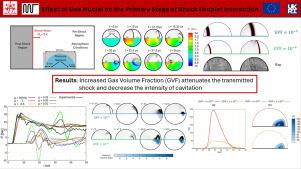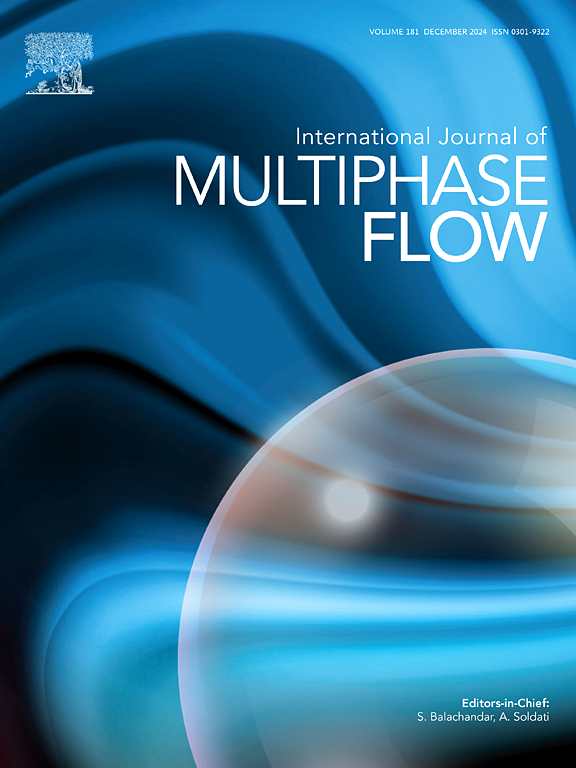Effect of gas nuclei on the primary stage of shock–droplet interaction
IF 3.8
2区 工程技术
Q1 MECHANICS
International Journal of Multiphase Flow
Pub Date : 2025-10-10
DOI:10.1016/j.ijmultiphaseflow.2025.105478
引用次数: 0
Abstract
The presence of entrapped gas in liquids is well-documented, arising from gas solubility, surface irregularities, or prior phase-change events. In this study, simulations are carried out replicating an experiment involving a Mach 2.4 Planar shock interacting with a cylindrical water column, and the results are benchmarked against experimental pressure measurements in which the presence of entrapped air is reported. The liquid droplet is modelled as a homogeneous mixture of liquid and gas using a multiphase flow framework, and a novel relaxation approach is introduced to capture non-equilibrium effects within the mixture region. The effects of Gaseous Volume Fraction (GVF) and relaxation rate on shock attenuation, wave propagation speed, and cavitation are explored. The results reveal that increasing GVF enhances shock attenuation and slows down the wave propagation speed due to the mixture’s higher compressibility. A non-monotonic relationship between relaxation rate and pressure peak intensity is observed, governed by the effect of the relaxation rate on shock diffusivity, with maximum attenuation occurring at intermediate rates. At high GVF, the low wave propagation speed leads to an interaction between the shocks formed internally and around the droplet, which suppresses the rarefaction wave formation. Regarding cavitation, results indicate that lower GVF promotes stronger gas growth due to less shock attenuation. Finally, this study provides a physical explanation for the temporal pressure variations reported in prior numerical works and highlights the critical role of entrapped gas in shock–droplet interaction dynamics.

气体核对冲击-液滴相互作用初级阶段的影响
由于气体溶解度、表面不规则或先前的相变事件,液体中存在圈闭气体是有充分证据证明的。在这项研究中,模拟进行了一个涉及2.4马赫平面激波与圆柱形水柱相互作用的实验,并将结果与实验压力测量结果进行了基准测试,其中报告了夹持空气的存在。采用多相流框架将液滴建模为均匀的液气混合物,并引入了一种新的松弛方法来捕捉混合物区域内的非平衡效应。探讨了气体体积分数(GVF)和弛豫速率对激波衰减、波传播速度和空化的影响。结果表明,由于混合气具有较高的可压缩性,增大GVF可以增强激波衰减,减缓波的传播速度。弛豫速率和压力峰值强度之间存在非单调关系,由弛豫速率对激波扩散率的影响决定,在中间速率下衰减最大。在高GVF下,低波传播速度导致液滴内部和周围形成的激波相互作用,抑制了稀薄波的形成。在空化方面,研究结果表明,由于激波衰减较小,较低的GVF促进了更强的气体生长。最后,本研究为先前数值研究报告的时间压力变化提供了物理解释,并强调了捕获气体在激波-液滴相互作用动力学中的关键作用。
本文章由计算机程序翻译,如有差异,请以英文原文为准。
求助全文
约1分钟内获得全文
求助全文
来源期刊
CiteScore
7.30
自引率
10.50%
发文量
244
审稿时长
4 months
期刊介绍:
The International Journal of Multiphase Flow publishes analytical, numerical and experimental articles of lasting interest. The scope of the journal includes all aspects of mass, momentum and energy exchange phenomena among different phases such as occur in disperse flows, gas–liquid and liquid–liquid flows, flows in porous media, boiling, granular flows and others.
The journal publishes full papers, brief communications and conference announcements.

 求助内容:
求助内容: 应助结果提醒方式:
应助结果提醒方式:


